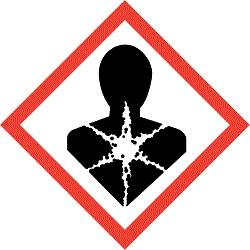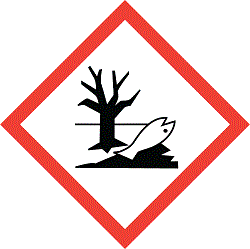
Example 10
The purpose of this example is to show calculation of Hazard to the aquatic environment according to Regulation (EC) No 1272/2008 (CLP).
There is a liquid mixture consisting of the following ingredients:
| Ingredient | Conc. % (w/w) | Classification | Specific Conc. Limits, M-factors and ATEs |
| Substance A | 0.9 |
Carc. 2: H351 Aquatic Acute 1: H400 Aquatic Chronic 1: H410 |
M = 10 |
| Substance B | 1.3 |
Carc. 2: H351 Aquatic Acute 1: H400 Aquatic Chronic 1: H410 |
M = 1 M = 10 000 |
| Substance C | 0.7 |
Acute Tox. 3: H301 Aquatic Acute 1: H400 Aquatic Chronic 1: H410 |
M = 10 000 |
| Substance D | 2.5 |
Repr. 2: H361d Acute Tox. 4: H302 Aquatic Acute 1: H400 Aquatic Chronic 1: H410 |
M = 1 M = 10 |
| Substance E | 0.6 |
Eye Dam. 1: H318 Aquatic Acute 1: H400 Aquatic Chronic 1: H410 |
M = 10 M = 10 |
| Substance H | 0.5 |
Lact.: H362 Aquatic Acute 1: H400 Aquatic Chronic 1: H410 |
− |
| Substance K | 1.8 |
Acute Tox. 4: H302 Aquatic Chronic 3: H412 |
− |
| Water | 91.7 | − | − |
Calculation of mixture classification.
Following ingredients are classified as acute toxicants:
| − | Substance C: Acute Tox. 3: H301 (oral). |
| − | Substance D: Acute Tox. 4: H302 (oral). |
| − | Substance K: Acute Tox. 4: H302 (oral). |
Because there are no data on LD50 (oral, dermal) / LC50 (inhalation) the acute toxicity category for appropriate route (oral, dermal, inhalation) should be converted to Acute Toxicity Estimate (ATE) (CLP, Annex I, Table 3.1.2).
Cut-off limits
| − | For 'Acute Tox. 1', 'Acute Tox. 2' and 'Acute Tox. 3' the cut-off limit 0.1 % is applied (CLP, Annex I, Table 1.1). Concentration of substance C is above this value, therefore, it is taken into account. |
| − | For 'Acute Tox. 4' the cut-off limit 1 % is applied (CLP, Annex I, Table 1.1). Concentrations of substances D and K are above this value, therefore, they are taken into account. |
Specific and Generic concentration limits
Neither specific nor generic concentration limits are applied for acute toxicity.
Calculation of oral Acute Toxicity
ATE values converted from oral acute toxicity categories:
| − | Substance C: Acute Tox. 3: H301 -> ATE = 100 |
| − | Substance D: Acute Tox. 4: H302 -> ATE = 500 |
| − | Substance K: Acute Tox. 4: H302 -> ATE = 500 |
100 / ATE mix = conc. C / ATE C + conc. D / ATE D + conc. K / ATE K
100 / ATE mix = 0.7 / 100 + 2.5 / 500 + 1.8 / 500
ATE mix = 6410.254
The value 6410.254 is above 2 000 (CLP, Annex I, Table 3.1.2). This does not lead to oral acute toxicity.
Classification of the mixture
The mixture is not classified in category acute toxicity.
Following ingredients are classified as serious damage to eyes / eye irritation:
| − | Substance E: Eye Dam. 1: H318. |
The mixture's pH is between 2 and 11.5, this does not lead to classification 'Eye Dam. 1'. Mixture contains no ingredients leading to the application of non-additivity approach, therefore, Additivity approach is applied.
Cut-off limits
| − | For serious damage to eyes / eye irritation the cut-off limit 1 % is applied (CLP, Annex I, Table 1.1). Concentration of substance E is below this value, therefore, it is not taken into account. |
Classification of the mixture
The mixture is not classified in category serious damage to eyes / eye irritation.
Following ingredients are classified as carcinogens:
| − | Substance A: Carc. 2: H351. |
| − | Substance B: Carc. 2: H351. |
Cut-off limits
| − | There is no generic cut-off limit for carcinogenicity (CLP, Annex I, Table 1.1), therefore, any concentration of an ingredient with such classification is taken into account. |
Specific and Generic concentration limits
| − | Because no specific concentration limits are applied for substances A and B, their concentrations must be compared to generic concentration limits. |
Calculation of 'Carc. 2'
| − | Concentration of substance A is below the generic concentration limit 1.0 % (CLP, Annex I, Table 3.6.2). This does not lead to classification 'Carc. 2'. |
| − | Concentration of substance B is above the generic concentration limit 1.0 % (CLP, Annex I, Table 3.6.2). This leads to classification Carc. 2 . |
Selection of hazard category
| − | The mixture is classified as 'Carc. 2'. |
Selection of hazard statements
| − | H351 corresponds to 'Carc. 2'. |
Selection of pictogram and signal word
| − | Pictogram GHS08 and signal word 'Warning' correspond to 'Carc. 2'. |
Selection of precautionary statements
| − | For H351 following precautionary statements are applied: P201, P202, P280, P308+P313, P405, P501. |
Following ingredients are classified as reproductive toxicants:
| − | Substance D: Repr. 2: H361d. |
| − | Substance H: Lact.: H362. |
Cut-off limits
| − | There is no generic cut-off limit for reproductive toxicity (CLP, Annex I, Table 1.1), therefore, any concentration of an ingredient with such classification is taken into account. |
Specific and Generic concentration limits
| − | Because no specific concentration limits are applied to substances D and H their concentrations should be compared to generic concentration limits. |
Calculation of 'Repr. 2'
| − | Concentration of substance D is below the generic concentration limit 3.0 % (CLP, Annex I, Table 3.7.2). This does not lead to classification 'Repr. 2'. |
Calculation of 'Lact.'
| − | Concentration of substance H is above the generic concentration limit 0.3 %. This leads to classification Lact. . |
Selection of hazard category
| − | The mixture is classified as 'Lact.'. |
Selection of hazard statements
| − | H362 corresponds to 'Lact.'. |
Selection of pictogram and signal word
| − | No pictogram and signal word are applied for 'Lact.'. |
Selection of precautionary statements
| − | For H362 following precautionary statements are applied: P201, P260, P263, P264, P270, P308+P313. |
Following ingredients are classified as hazardous to the aquatic environment:
| − | Substance A: Aquatic Acute 1: H400 / Aquatic Chronic 1: H410. |
| − | Substance B: Aquatic Acute 1: H400 / Aquatic Chronic 1: H410. |
| − | Substance C: Aquatic Acute 1: H400 / Aquatic Chronic 1: H410. |
| − | Substance D: Aquatic Acute 1: H400 / Aquatic Chronic 1: H410. |
| − | Substance E: Aquatic Acute 1: H400 / Aquatic Chronic 1: H410. |
| − | Substance H: Aquatic Acute 1: H400 / Aquatic Chronic 1: H410. |
| − | Substance K: Aquatic Chronic 3: H412. |
Cut-off limits
For 'Aquatic Acute 1' and 'Aquatic Chronic 1' cut-off limit is calculated according to formula 0.1/M (CLP, Annex I, 4.1.3.1):
| − | Substance A has established one M-factor (M = 10), which applies to both 'Aquatic Acute 1' and 'Aquatic Chronic 1'. Concentration of substance A is above 0.01 % (0.1/10), therefore, A is taken into account for calculation of both 'Aquatic Acute 1' and 'Aquatic Chronic 1'. |
| − | Substance B has established two different M-factors: M = 1 applies to 'Aquatic Acute 1' and M = 10 000 applies to 'Aquatic Chronic 1'.
− concentration of substance B is above 0.1 % (0.1/1), therefore, B is taken into account for calculation of 'Aquatic Acute 1', − concentration of substance B is above 0.00001 % (0.1/10 000), therefore, B is taken into account for calculation of 'Aquatic Chronic 1'. |
| − | Substance C has established one M-factor (M = 10 000), which applies to both 'Aquatic Acute 1' and 'Aquatic Chronic 1'. Concentration of substance C is above 0.00001 % (0.1/10 000), therefore, C is taken into account for calculation of both 'Aquatic Acute 1' and 'Aquatic Chronic 1'. |
| − | Substance D has established two different M-factors: M = 1 applies to 'Aquatic Acute 1' and M = 10 applies to 'Aquatic Chronic 1'.
− concentration of substance D is above 0.1 % (0.1/1), therefore, D is taken into account for calculation of 'Aquatic Acute 1', − concentration of substance D is above 0.01 % (0.1/10), therefore, D is taken into account for calculation of 'Aquatic Chronic 1'. |
| − | Substance E has established two the same M-factors (M = 10), which applies to both 'Aquatic Acute 1' and 'Aquatic Chronic 1'. Concentration of substance E is above 0.01 % (0.1/10), therefore, E is taken into account for calculation of both 'Aquatic Acute 1' and 'Aquatic Chronic 1'. |
| − | There is no M-factor in Table 3 of Annex VI to CLP established for substance H. Person responsible for classification decided to use M = 1 for both 'Aquatic Acute 1' and 'Aquatic Chronic 1'. Concentration of substance H is above 0.1 % (0.1/1), therefore, H is taken into account for calculation of both 'Aquatic Acute 1' and 'Aquatic Chronic 1'. |
For Aquatic Chronic categories 2-4 the generic cut-off limit 1 % is applied (CLP, Annex I, Table 1.1):
| − | Concentration of substance K is above 1 %, therefore, it is taken into account. |
Specific and Generic concentration limits
Neither specific nor generic concentration limits are applied for acute toxicity.
Calculation of 'Aquatic Acute 1'
| − | Concentrations of substances A, B, C, D, E and H must be multiplied by their corresponding M-factors and obtained values must be summed.
(conc. A × M) + (conc. B × M) + (conc. C × M) + (conc. D × M) + (conc. E × M) + (conc. H × M) = (0.9 × 10) + (1.3 × 1) + (0.7 × 10 000) + (2.5 × 1) + (0.6 × 10) + (0.5 × 1) = 7019.3 The obtained value is above 25 % (CLP, Annex I, 4.1.3.5.5.3.1 and Table 4.1.1). This leads to classification Aquatic Acute 1 . |
Calculation of 'Aquatic Chronic 1'
| − | Concentrations of substances A, B, C, D, E and H must be multiplied by their corresponding M-factors and obtained values must be summed.
(conc. A × M) + (conc. B × M) + (conc. C × M) + (conc. D × M) + (conc. E × M) + (conc. H × M) = (0.9 × 10) + (1.3 × 10 000) + (0.7 × 10 000) + (2.5 × 10) + (0.6 × 10) + (0.5 × 1) = 20040.5 The obtained value is above 25 % (CLP, Annex I, 4.1.3.5.5.4.1 and Table 4.1.2). This leads to classification Aquatic Chronic 1 . |
Calculation of 'Aquatic Chronic 2'
| − | Concentrations of substances A, B, C, D, E and H must be multiplied by their corresponding M-factors for 'Aquatic Chronic 1' and multiplied by 10.
(M × 10 × conc. A) + (M × 10 × conc. B) + (M × 10 × conc. C) + (M × 10 × conc. D) + (M × 10 × conc. E) + (M × 10 × conc. H) = (10 × 10 × 0.9) + (10 000 × 10 × 1.3) + (10 000 × 10 × 0.7) + (10 × 10 × 2.5) + (10 × 10 × 0.6) + (1 × 10 × 0.5) = 200405 The obtained value is above 25 % (CLP, Annex I, 4.1.3.5.5.4.2 and Table 4.1.2). This leads to classification Aquatic Chronic 2 . |
Calculation of 'Aquatic Chronic 3'
| − | Concentrations of substances A, B, C, D, E and H must be multiplied by their corresponding M-factors for 'Aquatic Chronic 1' and multiplied by 100. Obtained values must later be summed with concentration of substance K.
(M × 100 × conc. A) + (M × 100 × conc. B) + (M × 100 × conc. C) + (M × 100 × conc. D) + (M × 100 × conc. E) + (M × 100 × conc. H) + conc. K = (10 × 100 × 0.9) + (10 000 × 100 × 1.3) + (10 000 × 100 × 0.7) + (10 × 100 × 2.5) + (10 × 100 × 0.6) + (1 × 100 × 0.5) + 1.8 = 2004051.8 The obtained value is above 25 % (CLP, Annex I, 4.1.3.5.5.4.3 and Table 4.1.2). This leads to classification Aquatic Chronic 3 . |
Calculation of 'Aquatic Chronic 4'
| − | Concentrations of all ingredients summed.
conc. A + conc. B + conc. C + conc. D + conc. E + conc. H + conc. K = 0.9 + 1.3 + 0.7 + 2.5 + 0.6 + 0.5 + 1.8 = 8.3 The obtained value is below 25 % (CLP, Annex I, 4.1.3.5.5.4.4 and Table 4.1.2). This does not lead to classification 'Aquatic Chronic 4'. |
Selection of hazard category
| − | The mixture is classified as 'Aquatic Acute 1'. |
| − | Classification category 'Aquatic Chronic 1' is more severe than 'Aquatic Chronic 2' and 'Aquatic Chronic 3', therefore, mixture is classified as 'Aquatic Chronic 1'. |
Selection of hazard statements
| − | H400 corresponds to 'Aquatic Acute 1'. |
| − | H410 corresponds to 'Aquatic Chronic 1'. Because H410 is applied, the statement H400 don't have to be used (Article 27 and Part 1 of Annex III to CLP). |
Selection of pictogram and signal word
| − | Pictogram GHS09 and signal word 'Warning' correspond to both 'Aquatic Acute 1' and 'Aquatic Chronic 1'. |
Selection of precautionary statements
| − | For H410 following precautionary statements are applied: P273, P391, P501. |
signal word and P statements
| Classification categories | Classification | H statements | Pictograms | Signal words | P statements |
| Carcinogenicity | Carc. 2 | H351 |  GHS08 |
Warning | P201, P202, P280, P308+P313, P405, P501 |
| Reproductive toxicity | Lact. | H362 | − | − | P201, P260, P263, P264, P270, P308+P313 |
| Hazardous to the aquatic environment | Aquatic Acute 1 Aquatic Chronic 1 |
H410 |  GHS09 |
Warning | P273, P391, P501 |
Classification and labelling of the mixture
| Classification: | Carc. 2, Lact., Aquatic Acute 1, Aquatic Chronic 1 |
| Hazard statements: | H351, H362, H410 |
| Pictograms: |  |
| GHS08 | |
 |
|
| GHS09 | |
| Signal word: | Warning |
| Precautionary statements: | P201, P202, P260, P263, P264, P270, P273, P280, P308+P313, P391, P405, P501 |
According to Article 28(3) of CLP if mixture has more than 6 precautionary statements, supplier should select among of them the most important 6 statements that should be indicated on the label. The same selected statements should be placed in section 2.2 'Hazards identification' of safety data sheet (SDS). The rest may be placed in section 16 'Other information' of SDS.